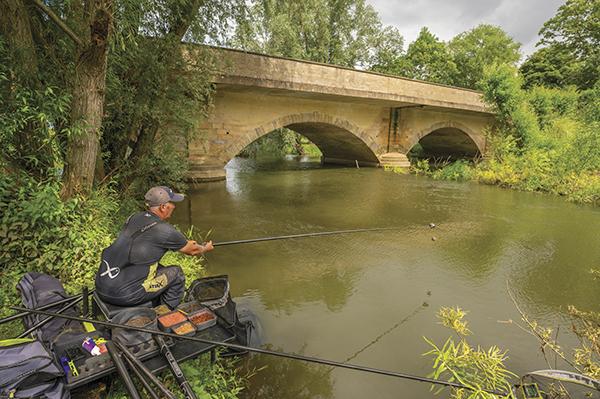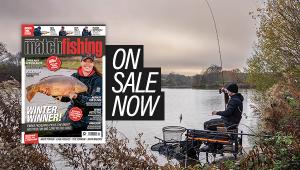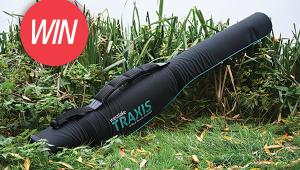No Roach, Same Approach

There’s nothing quite getting back on the rivers again after an enforced three-month layoff, and typically the fishing on most river venues can be described as iffy during the first few weeks of the season. This year has been a little different with a lot of natural behaviour of animals and plants being a month behind compared to what they typically are because of our strange weather patterns. That means the roach have yet to switch on on one of my local stretches of the River Ouse near Newport Pagnell and as I’ve got a ticket booked for the open match here next weekend, I thought I needed to get on the river and have a practice.
I’m fishing the Sherington stretch and the matches on here are usually every two or three weeks and are usually sell-outs but limited to around 45 pegs. It’s probably one of the most idyllic looking stretches of the Ous,e with plenty of reed beds, gravel runs, shallow areas, deeper areas, streams entering the river, overhanging bushes and trees… you name it, this stretch has got the lot. After the Sherington stretch the river then runs downstream to Olney, which is the most noted stretch of this part of the Ouse with match anglers and they run opens on that stretch every Tuesday or Wednesday.
The Peg
The peg I’ve chosen today (or more accurately Dave the photographer has chosen!) is the peg running on to Sherington Bridge and it’s one of those pegs that you’d run to in match. However, without the roach feeding at the minute, it becomes a different proposition and I’ll be fishing for small dace, small chub and perch mainly, and the target weight realistically is between 8 and 10lb.
Even though I’m not expecting to catch roach, I don’t change my approach with regards to baits and feeding and I’ll fish and feed the same as I would if roach were the main target species. For me that means feeding groundbait and pinkies and then loose feeding casters and maybe some hemp over the top. The groundbait will concentrate the fish on the bottom and the loose fed casters will hopefully draw fish up from downstream. I could possibly feed a chopped worm line as well for perch and if it was match I’d probably do this, but today I want to try and see what weight is possible by targeting the small dace, chublets, bleak and hopefully the odd roach too in close. Normally though, once we get further into the season it would be out and out roach here but like I said, my approach to baits and feeding would be exactly the same in that scenario. There are odd skimmers here too but enough to target them, and if any do show up I’ll catch them on my groundbait and pinkie approach.
The Perfect Mix
There is a tinge of colour in the river today and it looks perfect, but even if it was clear I’d still go with the groundbait and pinkie approach. I like a dark coloured mix and I think it’s important to offer the fish some food content in the groundbait, which helps them settle over the feed for longer.
My mix is 1.5kg of Supercharged Natural Black from Hinders Bait and 0.5kg of brown crumb. The Natural Black has some food content in the form of crushed hemp and other particles, and the brown crumb provides extra food content, which I feel is important. The result is a nice smelling dark groundbait that’s sticky and heavy enough to carry plenty of loose offerings and get down to the bottom before breaking up. I’ll add pinkies, casters and hemp to the mix before making up the balls for feeding. I’ve also got some maggots with me a for a change bait but I don’t expect to feed any.
Rigs
I’ve set up two rigs for the session – a 1g and a heavier 2g rig. My plan is to try and catch these small fish in close at four and five metres and see what happens. This will give me a better idea of what to do across and whether I’ll be better off feeding chopped worm over for perch or whether it’s best to turn it into another small fish line by feeding groundbait and pinkies come match day. However, in a match I’d be looking to feed chopped worm close in but down the peg in the slacker water.
I could set up a third rig with a strung bulk but I think with the pace of the river today I’d be out of my peg before the rig settled. The water at four and five metres is quite steady whereas further out into the river the float is more uneven with boils and swirls, and that’s why I’ve decided to fish this line because the fish will prefer the steadier flow. Both rigs have an olivette but on the lighter rig I’ll push that up to around one-third of the depth because I’ll be loose feeding casters over the top and this will give me the opportunity to catch on the way down and down the peg if they’re responding to the loose feed. The heavier 2g rig has the olivette pushed further towards the hook and this will get my bait down faster, so I can drop straight in on top of the groundbait and then ease the float down the peg.
You might be wondering why I don’t just feed groundbait and fish over it but in my mind I want to feed the casters to draw fish from further downstream on to the groundbait. The loose feed is probably going down past the bridge before it gets to the bottom but I believe the fish down there will find these and then come upstream looking for the source. There’s a nice depth in the swim of five and half feet and it’s the same pretty much all the way across to the large tree that’s fallen in the water on the far bank. So, my 2g rig has the olivette and then I’ve got four No10 Stotz spread a couple of inches apart down to the hooklength knot. On my lighter 1g rig the olivette is much further away from the hook but still with four No10 Stotz spread further apart below. The elastic on both rigs is a No4, which is perfect for these small fish and the main line 0.12mm to 0.08mm hooklengths and size 18 Matrix MXB-2 hooks.
Off We Go
To start the session I take four good handfuls of loose groundbait and then add my casters, hemp and pinkie particles before moulding four cricket ball sized balls that I’m going to pot in for maximum accuracy. I’ll start with my 1g rig with a single maggot on the hook just to see what’s about before I start refining rigs, presentation and feeding to suit how the fish are feeding on the day. I’m expecting bites to come straightaway because I’m targeting small fish and as soon as my rig is in the water I begin to loose feed seven or eight casters regularly over the top.
I’m lowering the rig in on a tight line because I want the hook bait to get ahead of the float before I start to ease the float through over the groundbait. It’s important when feeding the groundbait that you make sure it’s introduced slightly downstream so it’s easy to run the rig ont o it. If you feed directly in front of you your hook bait will have gone past the groundbait before it gets to the bottom. It’s a simple thing to remember but you’ll surprised just how many anglers don’t do this! It’s surprised me just how slow it is to begin with, with only the odd bite on a maggot and after 20 minutes I’ve only caught two or three small dace. Normally when you feed groundbait like I have the small fish are on it immediately and you get a good run of fish early, but that’s not happened today and it’s not even a match! I’ve also tried caster on the hook but that never produced a bite. I then started to miss bites on maggot so I put a pinkie on the hook to try and it was like pressing the on button. I began to get more bites and I started connecting with them, which was great. Only small fish as expected but I wish I’d started on the pinkie instead of wasting the first part of the session with maggot and caster on the hook.
Double Pinkie
Switching to double pinkie proved to be even better and although the fish weren’t that much bigger, the bites were better and the float sailed away in unmissable fashion rather jab under quickly. Every time I felt the bites slowed and the swim needed a boost, I topped up with another ball of groundbait and the bites returned immediately for a while before tailing off again, signalling the introduction of another ball. Sometimes it would be 20 minutes before another ball of groundbait was required, at other times it was 30 or 40. Occasionally the reintroduction of groundbait didn’t work and I couldn’t work out why initially, then I hooked the first of three pike and that answered my question! It’s frustrating getting the fish feeding how you want only to then have it all ruined by the presence of a pike. But that’s something you just have to deal with if it happens and on the positive side, if there are pike in the swim it normally means there are lot of small fish too.
The main species I’m catching is dace, but there is the odd small roach and chublet. Also when I feed another ball of hard groundbait, I manage to get one or two perch and they’re worth three or four dace in weight. The roach are still noticeable by their absence and I’m trying various ways of presenting the rig to see if anything increases the stamp of fish I’m catching. The best way seems to be to swing the rig out into the flow and then hold tight while the rig straightens up before letting it go and easing it over the groundbait. This results in better bites but there doesn’t seem to be anything I can do to increase the stamp, so it’s a case of getting my head down and catching as many as I can.
Moving Out
The swim did go on me towards the end of the session and even another ball of groundbait failed to get the fish back. I put this down to pike being in the swim, so what I decided to do was plumb across to the tree on the far bank and feed a ball of groundbait there. The fish were straight back on it over there with double pinkie on the hook but obviously it was much slower because of the distance. I managed to keep catching there until the end of the session and apart from one or two quiet spells, which I put down to pike, I’ve had bites all day long from small fish. The roach are still missing but with my groundbait and pinkie approach I don’t need to change anything in my approach. If the roach were feeding I would have fished and fed exactly the same and that’s the beauty of this method, it will catch whatever is feeding on the day and quite often outfish other tactics like loose feeding hemp and caster or maggots.
Editor’s note: Something happened during the match that doesn’t happen very often – Polly drew ‘the bomb hole’, which is arguably the worst peg on the stretch! It was a top five deep but he still managed 7lb 9oz, with 12lb winning the match.
- Log in or register to post comments













